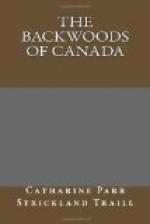[* It is stated that the North-West Company had a census of all the tribes, and that the whole Indian population of that immense continent did not now exceed 100,000 souls. In a Parliamentary document of 1834, the Indians of Lower Canada are estimated at 3,437, and those of Upper Canada at 13,700, which latter number is stated to include those on the shores of Lake Huron, and to the westward.-Ed.]
When next you send a box or parcel, let me have a few good tracts and hymn-books; as they prize a gift of this sort extremely. I send you a hymn, the one they sang to us in the wigwam; it is the Indian translation, and written by the hunter, Peter’s eldest son: he was delighted when I told him I wanted him to copy it for me, that I might send it across the seas to my own country, that English people might see how well Indians could write.
[Illustration: Red-bird]
[Illustration: Blue-bird]
The hunchback Maquin has made me a miniature canoe of birch-bark, which I send; you will prize it as a curiosity, and token of remembrance. The red and black squirrel-skins are for Jane; the feather fans, and papers of feathers, for Sarah. Tell the latter the next time I send a packet home, she shall have specimens fit for stuffing of our splendid red-bird, which, I am sure, is the Virginian nightingale; it comes in May or April, and leaves us late in the summer: it exactly corresponds to a stuffed Virginian nightingale that I saw in a fine collection of American birds. The blue-bird is equally lovely, and migrates much about the same time; the plumage is of a celestial blue; but I have never seen one otherwise than upon the wing, so cannot describe it minutely. The cross-bills are very pretty; the male and female quite opposite in colour, one having a lovely mixture of scarlet and orange on the breast and back, shading into greenish olive and brown; the other more like our yellowhammer, only it is not quite so bright in colour, though much softer, and more innocent-looking: they come to our windows and doors in the winter as familiarly as your robins. During the winter most of our birds depart; even the hollow tapping of the red-headed and the small speckled grey and white woodpecker ceases to be heard; the sharp chittering of the squirrel, too, is seldomer distinguished; and silence, awful and unbroken silence, reigns in the forest during the season of midwinter.
I had well nigh forgotten my little favourites, a species of the titmouse, that does not entirely forsake us. Of a bright warm, sunny day we see flocks of these tiny birds swinging among the feathery sprigs of the hemlocks or shrubby pines on the plains or in the forest; and many a time have I stayed my steps to watch their playful frolics, and listen to their gay warbling. I am not quite certain, but I think this is the same little bird that is known among the natives by the name of Thit-a-be-bee; its note, though weak, and with few changes, is not unpleasing; and we prize it from its being almost the only bird that sings during the winter.




